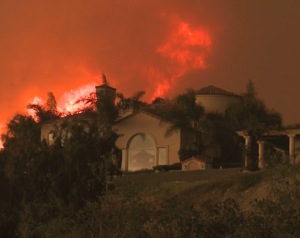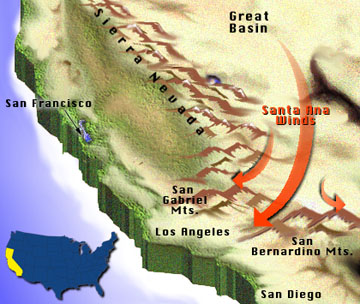Could set the stage for more severe spring wildfires
Hear my companion radio feature for The California Report.

Gusty winds up and down California have grounded aircraft and left hundreds of thousands without power this week. But so far, we’ve avoided the most feared consequence — major wind-driven wildfires. This is high season for the notorious winds known in the Southland as “Santa Anas,” and research suggests our changing climate may mean that season gets longer.
In Northern California, they’re called “Diablos” but the physics behind these legendary winter winds is essentially the same: air moves from high pressure to low.
“Generally a stationary high pressure system that sits over the Great Basin – Nevada and inland regions,” according to Norm Miller, who’s been modeling these winds on computers at Lawrence Berkeley National Lab for a few years now. “It sits there long enough and sort of links with the low pressure that’s offshore. And they set up a flow system,” Miller told me in a recent interview at the lab.

As the air squeezes through the canyons, it speeds up — 50-60 mile-an-hour winds are not uncommon. And when air is compressed, it gets hotter. Miller found an anecdote from 1859, when a ship recorded winds coming off the central coast at more than 130 degrees Fahrenheit — and this was over the ocean.
Normally, the season for Santa Anas would be starting to peak right about now, through December and January, and then start tailing off. But Miller has combined what we know about Santa Anas with established large-scale climate models, and found something interesting. He says his research so far suggests that given the way the Western climate is changing, high season for hot winds could be stretched out, with more Santa Anas overlapping with the dry season.
“And the danger would be that if we see it spread into the dry season longer, then the likelihood of a fire weather condition — high winds, dry air — which is what Santa Anas are conducive to producing, chances of fire are much greater,” says Miller.
If you were anywhere near Santa Barbara in 2009, you haven’t forgotten the Jesusita Fire. Before it was contained, flames consumed 80 homes and almost 9,000 acres. The video montage below was captured by news videographer Tim Walton, and is a graphic portrait of a classic wind-driven California fire.
That fire happened in May, which isn’t generally reckoned to be Santa Ana season, but Jesusita may have been a glimpse into the future — or not.
“It’s pretty complex,” says Alex Hall, a UCLA climatologist, who’s been studying the smaller-scale, regional factors that influence Santa Anas. He says the news isn’t all bad; that part of what sets the stage for these events is that cold air tends to pool inland in the winter, and the relatively mild temperatures on the coast tends to pull that air toward the ocean.
“When you have a changing climate, the land surface is warming up a lot more rapidly than the ocean, and that tends to weaken this mechanism,” Hall told me. That could mean fewer of these seaward blasts, at least during the winter months, as a kind of consolation.
“In trying to understand how fire will behave in the future, we have to look at the effect of precipitation on the fuel loads and we have to be looking at the effect of Santa Anas on fire behavior,” said Hall. “So I think there are some really interesting questions to look at.”
Like the man said, it’s pretty complex. But both scientists agree that we may be in for a shift in the Santa Ana season, which could set the stage for more serious wildfires in the springtime.
2 thoughts on “Santa Ana Wind Season May Be Stretched by Climate Change”
Comments are closed.


The article contradicts the headline. Norm Miller says they may intensify. Alex Hill says they moderate.
There is no contradiction. Hall has found some local influences that could moderate the frequency or intensity of SAOs during what are now the peak winter months–but as the post points out, both scientists agree on the seasonal shift. Not mentioned is that Hall has also found some evidence that offshore flows may be lower humidity in the future, which would not be a moderating factor.